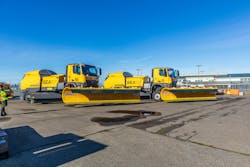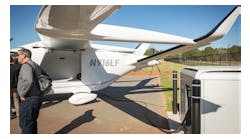Airports that experience snow must be ready to clear the runways no matter how much snow lands on the pavement.
In February 2019, Seattle-Tacoma International Airport (SEA) removed 3 million cubic yards of snow from its ramps and runways. To put that in perspective, the SEA website says that’s enough snow to fill 48 Olympic-sized swimming pools. That winter, the airport saw 21 inches of snow. The next biggest seasons were 2020-21 with 12.9 inches and 2016-17 with 11.2 inches.
The airport, which averages 1,200 to 1,300 flights per day, doesn’t usually see that much snow. In the last 10 seasons, the average was 6 inches. Based on that average, the airport budgets about 4,000 hours for snow removal.
The snow removal team is made up of 74 employees of the Port of Seattle and airport who are trained in snow removal and have a goal of clearing a runway in 30 minutes or less. Also on the team are 25 mechanics who maintain more than 50 pieces of equipment.
With 17 units, plow and broom combination units represent the biggest category of snow removal equipment. There also are nine tractor trailer units with 24-foot plows and eight fixed-chassis units with 20-foot plows.
Other equipment includes four high-speed brooms, three sander plows, four high-speed plows, four de-icing trucks for runways, taxiways and ramp areas; three with 75-foot booms and one boomless with a 50-foot spray width; five snow blowers used specifically on the runways; plus equipment dedicated to the landside.
At the start of the 2023-24 season, SEA introduced eight new Øveraasen RSC250 runway sweepers.
“SEA was looking to replace less effective, harder-to-maintain vehicles that were aging out,” said SEA Media Relations Manager Perry Cooper.
“The eight pieces replaced eight specific vehicles that dated back to the 1990s and early 2000s. The combos were able to replace two vehicles, a plow and a broom. It wasn’t a two to one directly, rather replacing the older fleet vehicles and adding to the overall fleet.”
Airport Improvement Project funding was used to purchase the renewable diesel models, which help the port authority’s fleet sustainability goals and are operated with just one operator.
“The new equipment is a big help in operational efficiency,” said Cooper. “The Øveraasen RSC250 is specifically for use on the ramp areas next to the terminal. Its maneuverability allows it to manage the tighter spaces in and around the gates and the combo unit replaces two pieces of equipment: a plow and a broom.”
The compact RSC250 has a working width of 3,600 mm (11.8 feet) and a turning radius of 7.19 m (23.6 feet). Snow clearing is asymmetric with blowing 140 m/s to 40,000 m3/h (459 feet per second to nearly 25 cubic miles per hour) and capacity is 234,000 m2/h (145 square miles per hour). The small amount of snow left behind from the plow/blower is cleaned with a 23,500 CFM air blower.
Team Eagle Ltd. Commercial Business Manager Ben McKeown said the Øveraasen RSC250’s size is often the first feature that comes to mind.
“However,” he said, “there are several performance features that are unique to Øveraasen that set this unit above standard units. The plow, for example, is made of 3-foot sections that independently float/contour to the ground surfaces, greatly improving the performance. The fuel levels (in excess of 260 gallons) that this unit hold allows the airport to operate 40-50 hours without needing to refuel, which is a major benefit in snow events that may last more than a couple shifts.”
McKeown pointed out the location of the fuel tanks on all Øveraasen units: “Unlike most manufacturers, Øveraasen located their fuel tanks in front of the rear tires. This means that should an operator accidentally back into something – or someone back into them – the fuel tanks are not at risk of being punctured.”
The fuel tanks are two separate tanks (right and left) that work harmoniously during operation/refueling. In the event that damage does occur to one tank, that tank can be drained/patched. The other tank can be isolated and the unit can continue operating with one tank until it can be scheduled for maintenance, he said.
Other features include Mercedes and Volvo chassis options, a fiber glass engine hood, re-enforced plastic bumpers, commercial tires with Norwegian winter grip and a 3-foot diameter brush.
Two options SEA chose include on-machine QR coding and safety stairs. Maintenance team members can scan the QR codes, then pull up a page of parts and the service manual they need to determine what service is required.
According to McKeown, SEA has started a trend for North American airports. While visiting the Øveraasen factory in Norway, SEA team members noticed that the ladders traditionally used to enter the machines may be too high/steep for North American operators and asked if Øveraasen’s engineering team could fabricate stairs for better access. They could and since then, McKeown estimates 90 percent of the Øveraasen units going to North America have this staircase by request.
“Climbing ladders into machines, which are by nature covered in snow, ice, even extremely slippery runway chemicals can be dangerous,” he said, emphasizing that with SEA’s suggestion, Øveraasen was able to introduce a new industry safety standard.
Another option, which SEA chose and is available on all Øveraasen units, is the Øveraasen Fleet Cloud system.
McKeown described, “This software platform – which is unique to Øveraasen in the industry – allows airport management to see their units in the field, and in real-time, view fuel levels, hydraulic capacities, and can even view the pattern setting their operators are running the machines at as well as see the life that is left on cassettes before needing to change out, allowing them to better plan this task.”
Øveraasen Fleet Cloud also allows for maintenance staff to receive notifications if there is an issue with a machine. Work orders are created within the system, which allows maintenance staff to track the issue, as well as the maintenance history of each machine.
“Should the airport allow it, these notifications can also be sent to Øveraasen and Team Eagle service staff at the same time,” he said, “meaning the instant an issue may arise, the airport maintenance team as well as Øveraasen/Team Eagle service technicians all receive the same notification, drastically reducing down-time and allowing for rapid response.”
Calibration of the Øveraasen RSC250 is automatic. “This means that the sweeper automatically adjusts the speed/pattern as the cassettes/broom wears. Instead of dropping down x number of inches every set interval, the machine slowly lowers the cassettes millimeter by millimeter, as required,” he said. These things can all be monitored/adjusted through the Øveraasen Fleet Cloud System.
Another option that SEA did not include is autonomous operation, which requires “major under the hood hardware installations at the time of build” and cutting-edge technology in the cab, as well as significant airport mapping. McKeown said some North American airports have units that are autonomous-ready, hardware is installed and tech/software will be added upon approval from various governing bodies. Airports in Europe, including Oslo Airport, are using autonomous technology, he said.
All sizes of airports can benefit with the Øveraasen RSC250, McKeown said.
“Larger airports will mainly use this unit in and around the apron area, as it has the capabilities of getting into tighter areas that 60-foot-plus units cannot,” he said.
“Smaller airports, who may face storage and staffing issues, may also benefit from use of the RSC250 since it can complete the work of multiple units. One option the RSC250 has (which Seattle-Tacoma did not need, but other units arriving in North America do), is the chemical tank/spray bar. This 3,000L/762-gallon unit has a 9 ft – 52 ft spray width, which means that the RSC unit is capable of replacing a plow/sweeper truck and chemical truck, allowing one operator at a smaller airport to complete the tasks of two.”



